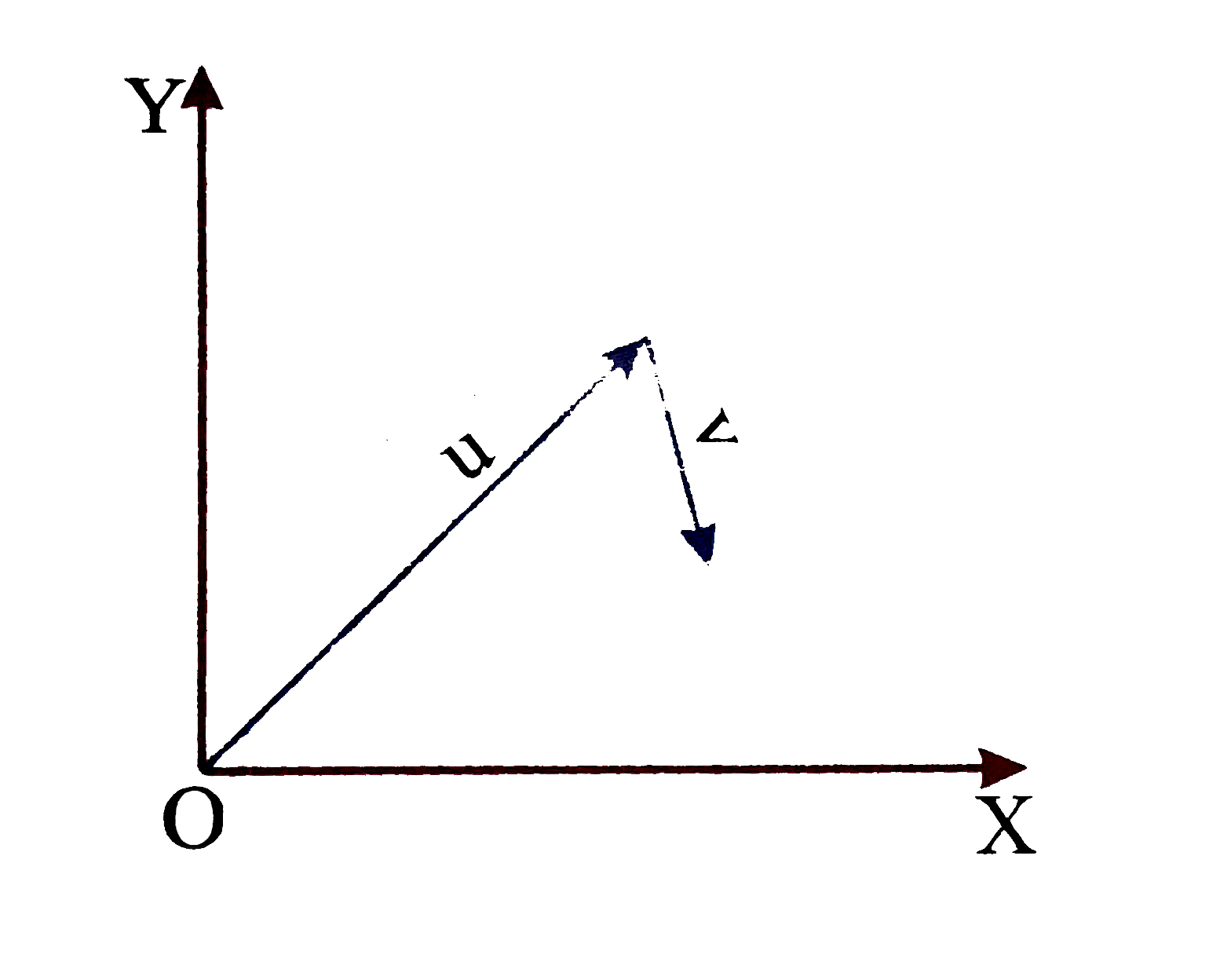Let →u=u1ˆi+u2ˆj+u3ˆk be a unit vector in R3and→w=1√6(ˆi+ˆj+2ˆk) , Given that there exists a vector →v in R3 such that |→u×→v|=1and→w.(→u×→v)=1 which of the following statements is correct ? (a)there is exactly one choice for such →v (b)there are infinitely many choices for such →v (c)if ˆu lies in the xy - plane then |u1|=|u2| (d)if ˆu lies in the xz-plane then 2|u1|=|u3|
there is exactly one choice for such →v
there are infinitely many choices for such →v
if ˆu lies in the xy - plane then |u1|=|u2|
if ˆu lies in the xz-plane then 2|u1|=|u3|
The correct Answer is:B, C
To solve the problem, we start with the given information about the vectors →u and →w.
1. Understanding the Vectors:
- The unit vector →u=u1^i+u2^j+u3^k has a magnitude of 1, which implies:
u21+u22+u23=1
- The vector →w=1√6(^i+^j+2^k) is also a unit vector since:
|→w|=1√6√12+12+22=1√6√6=1
2. Condition on Cross Product:
- We are given that there exists a vector →v such that:
|→u×→v|=1
- This means that →u and →v are not parallel, and the magnitude of the cross product is equal to the area of the parallelogram formed by →u and →v.
3. Dot Product Condition:
- We also have the condition:
→w⋅(→u×→v)=1
- Taking the magnitude on both sides, we can express this as:
|→w|⋅|→u×→v|⋅cosα=1
- Since |→w|=1 and |→u×→v|=1, we have:
1⋅1⋅cosα=1⟹cosα=1⟹α=0∘
- This indicates that →w is parallel to →u×→v.
4. Perpendicularity:
- Since →w is parallel to →u×→v, it follows that →w is perpendicular to both →u and →v. Therefore:
→u⋅→w=0
- This leads to:
u1+u2+2u3=0
5. Analyzing the Statements:
- (a) There is exactly one choice for such →v: False. There are infinitely many choices for →v since →u can vary while satisfying the dot product condition.
- (b) There are infinitely many choices for such →v: True. As shown, for different values of u1,u2,u3, there are infinite vectors →v.
- (c) If →u lies in the xy-plane, then |u1|=|u2|: True. If u3=0, then u1+u2=0 implies u1=−u2.
- (d) If →u lies in the xz-plane, then 2|u1|=|u3|: True. If u2=0, then from u1+2u3=0, we get |u3|=2|u1|.
Thus, the correct statements are (b), (c), and (d).
- The unit vector →u=u1^i+u2^j+u3^k has a magnitude of 1, which implies:
u21+u22+u23=1
- The vector →w=1√6(^i+^j+2^k) is also a unit vector since:
|→w|=1√6√12+12+22=1√6√6=1
- We are given that there exists a vector →v such that:
|→u×→v|=1
- This means that →u and →v are not parallel, and the magnitude of the cross product is equal to the area of the parallelogram formed by →u and →v.
- We also have the condition:
→w⋅(→u×→v)=1
- Taking the magnitude on both sides, we can express this as:
|→w|⋅|→u×→v|⋅cosα=1
- Since |→w|=1 and |→u×→v|=1, we have:
1⋅1⋅cosα=1⟹cosα=1⟹α=0∘
- This indicates that →w is parallel to →u×→v.
- Since →w is parallel to →u×→v, it follows that →w is perpendicular to both →u and →v. Therefore:
→u⋅→w=0
- This leads to:
u1+u2+2u3=0
- (a) There is exactly one choice for such →v: False. There are infinitely many choices for →v since →u can vary while satisfying the dot product condition.
- (b) There are infinitely many choices for such →v: True. As shown, for different values of u1,u2,u3, there are infinite vectors →v.
- (c) If →u lies in the xy-plane, then |u1|=|u2|: True. If u3=0, then u1+u2=0 implies u1=−u2.
- (d) If →u lies in the xz-plane, then 2|u1|=|u3|: True. If u2=0, then from u1+2u3=0, we get |u3|=2|u1|.
Topper's Solved these Questions
- BOOK - CENGAGE ENGLISHCHAPTER - JEE 2019EXERCISE - single correct answer type1videos
JEE 2019
- BOOK - CENGAGE ENGLISHCHAPTER - JEE 2019EXERCISE - multiple correct answers type1videos
JEE 2019
- BOOK - CENGAGE ENGLISHCHAPTER - JEE 2019EXERCISE - chapter -3 multiple correct answers type2videos
JEE 2019
- BOOK - CENGAGE ENGLISHCHAPTER - INVERSE TRIGONOMETRIC FUNCTIONSEXERCISE - Archives (Numerical Value type)2videos
INVERSE TRIGONOMETRIC FUNCTIONS
- BOOK - CENGAGE ENGLISHCHAPTER - LIMITSEXERCISE - Comprehension Type4videos
LIMITS
Similar Questions
Let →u=u1ˆi+u2ˆj be a unit vector in xy plane and →w=1√6(ˆi+ˆj+2ˆk) . Given that there exists a vector →v " in " R3 " such that |→u×→v|=1 and →w. (→u×→v)=1 , then
View SolutionLet →u=u1ˆi+u3ˆk be a unit vector in xz-plane and →q=1√6(ˆi+ˆj+2ˆk). If there exists a vector →c in such that |→u×→c|=1and→q.(→u×→c)=1 .Then
View SolutionLet →uand→v be unit vectors such that →u×→v+→u=→wand→w×→u=→v . Find the value of [→u→v→w]
View SolutionFor three vectors, →u,→vand→w which of the following expressions is not equal to any of the remaining three ?
View SolutionIf →u=2ˆi−2ˆj+3ˆk and the final velocity is →v=2ˆi−4ˆj+5ˆk and it is covered in a time of 10 sec, find the acceleration vector.
View SolutionIf →u and →v be unit vectors. If →w is a vector such that →w+(→w×→u)=→v then →u.(→v×→w) will be equal to
View SolutionLet →u=ˆi+ˆj,→v=ˆi−ˆjand→w=ˆi+2ˆj+3ˆk If ˆn isa unit vector such that →u.ˆn=0and→v.ˆn=0, then |→w.ˆn| is equal to
View SolutionLet a,b,c denote the lengths of the sides of a triangle such that
(a−b)→u+(b−c)→v+(c−a)(→u×→v)=→0
For any two non-collinear vectors →uand→u,then the triangle isView SolutionFigure shows the orientation of two vectors u and v in the XY plane.
if →u=aˆi+bˆj and →v=pˆi+qˆj
which of the following is correct?
 View Solution
View SolutionFigure shows the orientation of two vectors u and v in the XY plane.
if →u=aˆi+bˆj and →v=pˆi+qˆj
which of the following is correct?
 View Solution
View Solution

